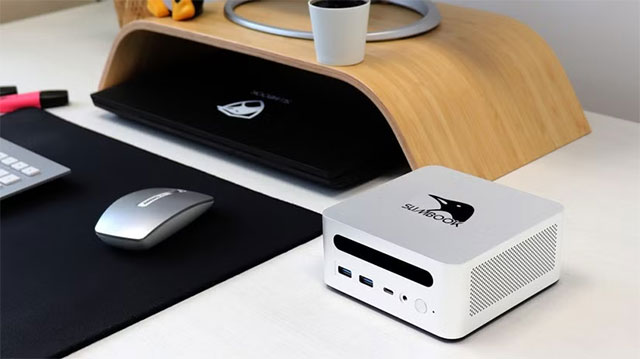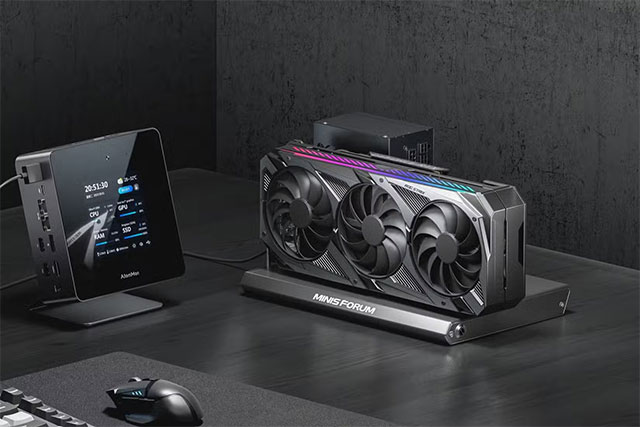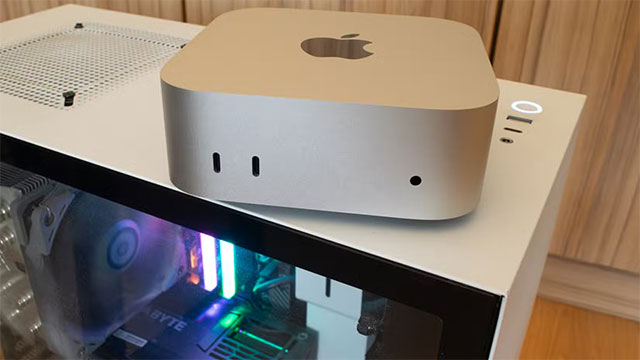Can a mini computer replace a desktop computer?
We often think of desktops as uncompromising, powerful machines that easily trump mini PCs in every way. But is that really true these days? While desktops are great for certain tasks, mini PCs can be great alternatives for most common use cases.
Mini computers are great everyday work tools.
If you use your desktop for relatively light work, like working with Google Workspace or Microsoft Office applications, light photo and video editing, maybe some hobby-level programming tasks, etc., then a mini PC can definitely replace a bulky desktop.
Minicomputers have come a long way in the past few years. Instead of being underpowered machines running on weak processors and insufficient memory, modern minicomputers today excel at supporting everyday tasks, even with low-cost models that cost just a few hundred dollars.

Thanks to Intel's recent focus on designing CPUs that combine high-performance and power-efficient cores (P-cores and E-cores), we now have some incredibly power-efficient E-core-only processors that pack a surprising amount of power.
CPUs like the Core i3-1220P, N100, and N150 can rival any mid-range desktop, while still being power efficient and capable of handling any of the above tasks with ease.
Combine these CPUs with at least 16GB of memory, and you've got a capable everyday machine that fits in the palm of your hand and still performs as quickly as any modern desktop or laptop.
The best part is that these CPUs are found in mini PCs that cost from under $150 to around $250, meaning you can get a worthy desktop replacement without paying the hefty price tag of a pre-built or small form factor (SFF) PC.
If you're willing to spend more, you can get machines powered by the latest and greatest mobile CPUs from AMD and Intel that come with incredibly powerful integrated graphics (iGPUs), which you can use for heavy-duty tasks like video editing at resolutions higher than 1080p, batch photo editing in Adobe Lightroom, working with CAD software (just make sure you have enough memory), music production, as well as professional coding and programming.
In short, a mini PC can do everything a desktop PC can do, unless we're talking about tasks that require a powerful desktop GPU (like 3D rendering) or a workstation-grade CPU, like an AMD Threadripper processor.
If you're a PC gamer, the answer is most likely "no."
PC gamers, on the other hand, should stick with their desktops. While it's true that mini PCs powered by AMD's newer mobile chips have powerful iGPUs that are capable of running even the latest AAA titles at 1080p with decent performance (above 30FPS), they're still pretty limited compared to even budget gaming PCs.

The GPU aspect is where mini PCs fall short compared to desktop PCs. A cheap gaming GPU from a few generations ago, like the RTX 2060, will still outperform even the most powerful integrated graphics card you can find in a mini PC.
Now, you can certainly pair an OCuLink-equipped mini PC with an external GPU (eGPU), but the problem is that setup will be more expensive than an equivalent gaming PC you build yourself.
Furthermore, dealing with an external GPU is a pain in the ass that requires a lot of troubleshooting. If you're not particularly tech-savvy, you're better off buying a pre-built gaming PC than trying to combine a mini PC and an eGPU.
Honestly, there are certain mini PCs, like the Beelink Gti12 Ultra and Gti14 Ultra, that come with a full-size PCIe 4.0 x8 slot, allowing you to pair them with a suitable eGPU dock and get a hassle-free gaming PC setup that doesn't limit GPU performance due to lack of bandwidth like other solutions (Thunderbolt and OcuLink).
However, they are more expensive than building an equivalent gaming PC yourself, so they shouldn't be used in place of building your own PC unless you have specific needs that require this type of solution.
Finally, there are some mini PCs aimed at gamers, like the ASUS ROG NUC line or the MINISFORUM AtomMan line, but they're "uncomfortably" expensive and generally not worth it unless you really want a super-small gaming PC and aren't willing to build an SFF gaming desktop yourself.
If you're a professional, you're probably better off sticking with a desktop. While high-end mini PCs can rival high-end laptops in CPU power, their integrated graphics are lacking. If you need a high-end discrete GPU for your work, you shouldn't even consider buying a mini PC.
Also, you won't find a Threadripper-equivalent mini PC that offers the same processing power. You can certainly use a mini PC for CPU-intensive tasks, but the time saved by using a HEDT (high-end) CPU is invaluable in situations where time is money.
If you like the idea of a compact desktop that excels at heavy-duty tasks, consider building an SFF PC based on a flagship desktop CPU like the AMD Ryzen 9950X or Intel Core Ultra 9 285K, or consider getting a Mac Mini M4 Pro or Mac Studio if you're okay with using macOS.

A Mac Mini with an M4 Pro chip can be a great 4K video editing or programming machine — for programming, you can even use the base Mac Mini M4. Meanwhile, the Mac Studio can be perfect for running large local LLM models and other AI-related tasks, thanks to its 512GB of blazing-fast unified memory.
Conclude
A mini PC can certainly replace a desktop PC; the only question is what you're using that desktop PC for. If the answer is everyday office work, music production, hobby or semi-professional video or photo editing, programming, and similar tasks that don't require a powerful GPU, then yes, you can get a comparable experience from a mini PC. But if you're a PC gamer who can't function without a high-performance GPU, or a professional who needs to get work done as quickly as possible, you're probably better off sticking with a desktop.
 Apple is working on an AI agent that can describe Street View scenes to blind people
Apple is working on an AI agent that can describe Street View scenes to blind people Microsoft shares detailed instructions on how to meet Windows 11 TPM requirements when migrating virtual machines
Microsoft shares detailed instructions on how to meet Windows 11 TPM requirements when migrating virtual machines Discover Weekly Spotify Turns 10 With Some Big Improvements
Discover Weekly Spotify Turns 10 With Some Big Improvements Scientists reveal what makes a scent so unpleasant
Scientists reveal what makes a scent so unpleasant Microsoft officially removes PowerShell 2.0 on Windows 11
Microsoft officially removes PowerShell 2.0 on Windows 11 Microsoft launches solution to protect email from Mail bombing
Microsoft launches solution to protect email from Mail bombing